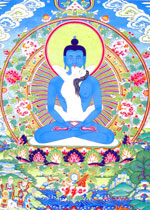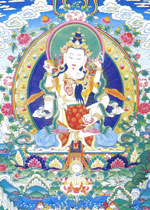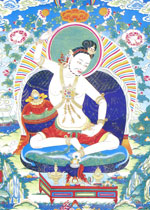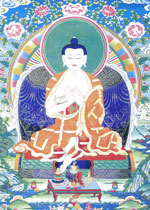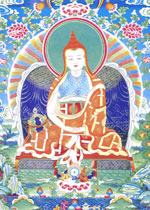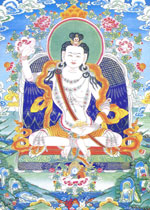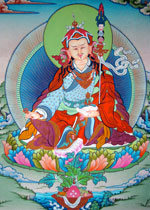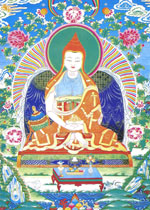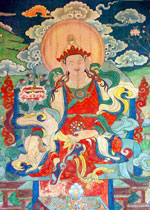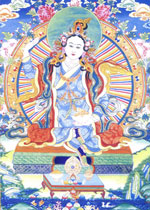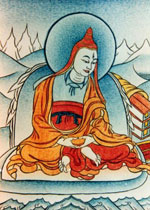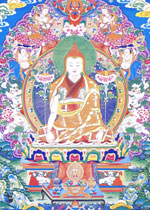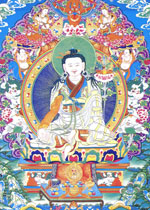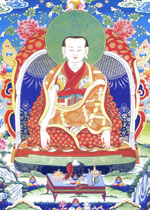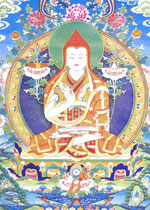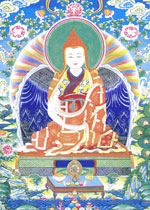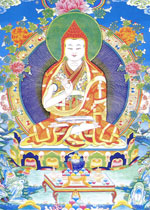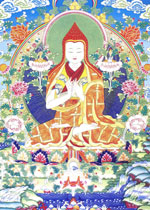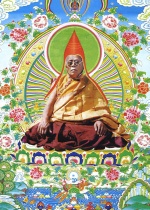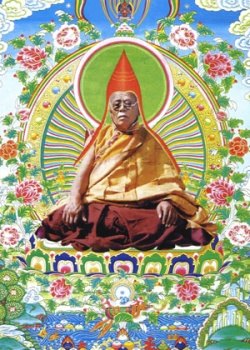Masters of the Longchen Nyingthik Lineage
Samantabhadra
Samantabhadra, the primordial Buddha is pure omniscience, the essence of the enlightened mind of all the Buddhas. Embracing Samantabhadri, the female primordial Buddha, their union represents the fusion of wisdom and compassion, the ultimate indivisibility of samsara and nirvana and the potential for Buddhahood inherent in all sentient beings.
Samanta means, "universally extending." Bhadra means "great virtue." Samantabhadra means to extend such great compassion that every sentient being is benefited and to practice so extensively and profoundly that all virtue is perfected.
Vajrasattva
Vajrasattva is the manifestation of the purity of body, speech, and mind of all the Buddhas. As a meditational deity Vajrasattva is visualized as an expression of mind's pure essence.
In this way negativities and obscurations are cleansed allowing Buddha nature to manifest. As a Bodhisattva, Vajrasattva saw that all beings suffered because of their negative karma and made a vow to free all beings of this karma.
Garab Dorje
The first human lineage-holder of the Dzogchen teaching was the Nirmanakaya Garab Dorje, an emanation of the Buddha Vajrasattva. He was born a son of a royal family in Oddiyana. He showed many special signs that he was not an ordinary child.
At age 7 he entered into a philosophical debate with 500 scholars and defeated all of them, without ever having studied himself. Afterwards he meditated on a mountaintop until his 32nd birthday. He received empowerments, instructions and entrustment of the Dzogchen tantras in an instant from Vajrasattva and attained the stage of 'no more learning.
With the help of dakinis he spent three years transcribing the teachings he had received. He meditated and taught for the rest of his life in Sitavana, a famous charnel ground northeast of Bodhgaya. When he died at the source of the Danatika river his body dissolved into immaculate space amid masses of rainbow light.
Shri Singha
Shri Singha was born in China and was a great scholar of wordly sciences. In a vision, Avalokitesvara instructed him to go to the Sosadvipa charnel ground in India where he would attain enlightenment. To prepare for his pilgrimage to India, Shri Singha studied different tantras for seven years on the sacred mountain of Wu T'ai Chan.
He then took ordination and maintained monastic discipline for 30 years. Avalokitesara appeared to him again and repeated his advice. Before departing for India Shri Singa engaged in a practice that resulted in achievement of miraculous powers, allowing him to travel to Sosadvipa very quickly. He met Manjushrimitra there and studied and practised with him for 25 years.
When Manjushrimitra achieved the rainbow body, Shri Singha received his master's final testament, and meditating with those instructions, he realized the essential meaning of Dzogchen. Shri Singha was also able to withdraw the texts Manjushrimitra had hidden in the rock near Bodhigaya. Upon his return to China, he hid the first three cycles of teaching near the Bodhi Tree Temple in China.
Following the instructions of a dakini, he concealed the Nyingthik cycle in a pillar in the Tashi Trigo Temple. After this Shri Singha lived in the Siljin charnel grounds meditating and giving teachings. As he achieved the rainbow body his final testament descended into the hands of his disciple, Jnanasutra.
Manjushrimitra
Manjushrimitra was born into a Brahman family to the west of Bodhgaya in India and became a great scholar. In a vision Manjushri instructed him to travel to the Sitavana charnel ground in India if he wished to reach enlightenment during his lifetime.
He met Garab Dorje there and studied the Dharma with him for 75 years. When Garab Dorje attained nirvana, Manjushrimitra beheld him in the sky in a mass of light. With the sound of a thunderclap a tiny golden casket descended from the light into the palm of his hand. Within it Manjushrimitra found the Three Words That Penetrate the Essence written on a leaf.
Just by seeing it he attained realization equal to that of his teacher. He classified the 6,400,000 verses of the Dzogchen teachings into categories, recorded the oral transmissions he had received and concealed them in a boulder marked with a crossed dorje. He meditated for many more years at Sosadvipa, a charnel ground, west of Bodhgaya and transmitted the Dzogchen teachings to Shri Singha.
Guru Rinpoche
Padmasambhava, an emanation of the Buddha Amitaba, was a great yogi from the region that borders on present-day Pakistan and Afghanistan. He brought Buddhism to Tibet in the eighth century and is affectionately called Guru Rinpoche. He spent more than 55 years in Tibet, manifesting countless wonders and is highly revered by all the schools of Tibetan Buddhism, and especially by the Nyingma.
Guru Padmasambhava gave teachings and transmission of the Vajrayana to hundreds of disciples. His main students, The Twenty Five Disciples, are the root incarnations of the masters of this day. With his principle disciple, Yeshe Tsogyal, he concealed thousands of hidden teachings or Termas in many places for the benefit of future generations.
Some termas are discovered within the mindstream of realized disciples, and are revealed when most appropriate for the times. In this way each successive generation of students is able to make a new beginning with a fresh revelation that is suited to its particular needs and capacities. Similarly, the distance from the Buddha to the practitioner is very short when a revelation is fresh and direct and there is no possibility of loss or corruption in the line of transmission. Through the Terma tradition the Nyingma school has been able to stay in close and continual contact with the spirit, energy and inspiration of Guru Rinpoche.
Guru Rinpoche appeared miraculously in the blossom of a lotus in Lake Danakosha, the "Ocean of Milk" in South West Oddiyana. When the king saw the child sitting on the lotus, he was filled with delight and invited the him to the palace as his son and religious guide. The child was named Padmasambhava, the "lotus-born."
Padmasambhava killed the son of a wicked minister and transferred his consciousness. As a result he was banished form the country to the fearful cemetery of Sitavana where he gradually he accomplished the common and uncommon siddhis and came to be known as Rodravajrakala.
In order to inspire faith towards the teachings in disciples of the future, he traveled to Bodhgaya and many other places receiving teachings from many scholars, accomplished masters and dakinis. By listening just once, he comprehended and accomplished the whole Vinaya, Sutra and Abhidharma, as well as the teachings of the outer and inner secret mantra, oral transmissions, and the pith instructions of the highest tantra of Atiyoga.
He took princess Mandarava, daughter of the king of Zahor, as his consort. In the mountain cave of Maratika, in Nepal, they performed the accomplishment rituals of longevity and actualised the immortal vajra body.
Guru Rinpoche returned to Oddiyana disguised as a beggar but many people recognised him and he was sent to be burned alive in a sandalwood fire. When the fire was lit, he miraculously transformed it into a huge lake filled with lotuses. Seated with his consort on a giant lotus in the middle of the lake, the king, ministers, and people were astounded and developed great faith in him.
Guru Rinpoche's activities and accomplishments in Tibet
When Lord Buddha gave Avalokitesvara the responsibility of taming the land of Tibet, Avalokitesvara looked at the barbaric land and shed tears of compassion. From these tears the goddesses Ganga and Gangchungma were born. Gangchungma stole some flowers and due to her decline in merit she was unable to take rebirth as a god and took rebirh in the human realm as the woman, Dechogma.
Dechogma naturally had great faith in the Dharma and commissioned the construction of a magnificent stupa in Boudha near Kathmandu. Although she died before the stupa was finished, her sons completed the work. They each prayed to be reborn as a Dharma king, a great learned khenpo, a powerful tantric master, and a messenger that would bring the other three together.
One son was reborn as Trisong Detsen, the 38th king of Tibet and an incarnation of Manjushri. Another was reborn as the king's messenger who invited the reincarnations of the other two sons, the great Khenpo Shantarakshita and the tantric master Padmasambhava from India. Recalling his past aspirations, Padmasambhava accepted the invitation, and on his way he subdued the demons of Tibet, transforming them into faithful guardians of the Dharma.
The king, guru and khenpo together constructed Tibet's first great monastery at Samye. They gave vows to Tibet's first seven monks, standardised translation methods, supervised translation of most of the sutras and tantras from Sanskrit to Tibetan, and firmly established the tradition of study, contemplation and meditationy radiating the Buddha Dharma in Tibet.
Guru Rinpoche miraculously walked upon the entire land of Tibet and blessed all the mountains, lakes and caves as places for accomplishment. With Yeshe Tsogyal, he concealed eighteen varieties of treasure including texts, material wealth, holy image, and made prophesies regarding the future manifestation of these treasures, including the revealer, the protector of the treasure, and the time of revelation.
Jnanasutra
Jnanasutra was born to a low caste family in Kamashila, eastern India. Jnanasutra became a scholar and traveled to Bodhgaya where he met Vimalamitra. Vajrasattva appeared to them both and instructed them to travel to the Bodhi Tree Temple in China to meet Shri Singha. Jnanasutra obeyed Vajrasattva's advice only after his friend Vimalamitra returned from China with glorious news of his meeting with their master.
When Jnanasutra arrived at the temple, a dakini instructed him to go to the Siljin charnel ground. He served his master for three years and then beseeched him for teachings. He stayed with the master receiving teachings and empowerments for many years. During this time Shri Singha often behaved in mysterious ways, wandering in charnel grounds, transforming into various forms, mingling with the dakinis and facing frightening beings without the slightest fear. Eventually Shri Singha told Jnanasutra that the texts of the teachings would appear when the time was right.
Seven days after his master left him to visit the King of the country of Li, Jnanamitra saw Shri Singha appear in the sky and knew that he had passed on. He received a casket containing the verses called the Seven Nails and instructions to extract the Nyingthik teachings from their hiding place at the Tashi Trigo Temple, and to meditate on them at the Bhasing charnel ground in India.
Jnanasutra returned to India with the texts and lived in the Bhasing charnel ground teaching the Nyingthik (Heart Essence) to dakas and dakinis. He also transmitted the teachings to his friend and disciple, Vimalamitra, and entrusted to him the texts of the entire oral tradition. At the end of his life his mortal body dissolved into a body of light.
Vimalamitra
Vimalamitra was born in western India. While living in Bodhgaya, he met Jnanasutra. Vajrasattva appeared to them and pointed out that they had achieved nothing through five hundred rebirths as scholars. If they aspired to reach Buddhahood in this lifetime, they should go to China to find their master Shri Singha at the Bodhi Tree Temple.
Leaving his friend behind, Vimalamitra, highly motivated, immediately set out for China and found Shri Singha as Vajrasattva had predicted. Over twenty years he received instruction on the outer, inner and secret teaching of the oral lineage. Completely satisfied - although the master had not given him the texts - he returned to India.
Meeting Jnanasutra, Vimalamitra related what he had received and accomplished and Jnanasutra immediately decided to travel to China to meet Shri Singha. Years later, still intent on his meditations and doing tantric practice, Vimalamitra was visited by dakinis who instructed him to go to the Bhasing charnel ground if he wanted to receive deeper instructions.
At Bhasing, he met his old friend Jnanasutra and begged from him the instructions he had missed. Jmanasutra bestowed the empowerments, instructions and texts. Vimalamitra meditated on the teachings he received for ten years before Jnanasutra achieved the rainbow body and left him with his final legacy, a tiny jeweled casket containing the verses called Four Methods of Contemplation.
He instantly achieved realization equal to that of his master. He made three copies of the texts and concealed two in secret places and entrusted the third to the dakinis.
Later, Vimalamitra was invited to Tibet by the translators Kawa Peltsek and Chokro Lui Gyeltsen, emissaries of King Trisong Detsen, and he was welcomed as a great master. Yudra Nyingpo became his collaborator and they translated a variety of Dzogchen texts. He concealed the translated texts at Gekong in Chimpu.
After thirteen years in Tibet he departed for the Five Peaks in China and there attained the rainbow body. He vowed to send an incarnation to Tibet every century to carry out the work of maintaining and disseminating the Nyingthik teachings for as long as the Buddha Dharma exists.
Yeshe Tsogyal
The Nyingma tradition regards Yeshe Tsogyal as an emanation of Samantabhadri, the primordial female Buddha. Born as a merchant during the lifetime of a former Buddha, Yeshe Tsogyal went before him and vowed not to be reborn except for the benefit of beings. She manifested as Ganga, the Indian goddess who sprang from Lord Shiva's topknot to flow as the Ganges, the river watering the plain of north India, and then as Saraswati, the Indian goddess of the flow of language and music. She was also a disciple of Buddha Shakyamuni. According to Nyingma tradition, in 8th century Tibet, Guru Rinpoche invoked Saraswati to manifest as a woman who would help disseminate the Mantrayana.
This remarkable hermit saint, the consort of Guru Rinpoche, is sometimes shown in Nirmanakaya form, as a woman in dressed in traditional Tibetan clothing, seated and holding curved knife and skullcup. As a meditational diety she appears as the Queen of Great Bliss, a red figure holding a damaru drum in her right hand and a curved knife in her left.
Yeshe Tsogyal (777-837 A.D.) was born to the princely Kharchen family. At her birth spring of fresh water burst from the ground and formed a pond next to her house. This pond came to be known as 'Lha-tso', the divine lake. Later the spot became a famous pilgrimage site for generations of devotees.
Yeshe Tsogyal was brutally raped by her first suitor and fought over by her second. When she fled from them, she was captured and placed in the Emperor's harem. Later the Emperor offered her as a consort to Guru Rinpoche.
Guru Rinpoche set her free, and she became his disciple at age 16. When she received empowerment her flower fell on the sacred mandala of Vajrakilaya and through practicing the sadhana she rapidly gained accomplishment. She then received all of the Guru Rinpoche's teachings and became his spiritual heir. She travelled all over Tibet with her Precious Guru, blessing particular locations and depositing treasure-texts for the benefit of future beings.
She went into meditation retreat in 796 and did not come out until 805, after her great Guru had already left Tibet. She finally emerged as fully enlightened Buddha. Possibly in 837, but perhaps later, she transcended worldly existence, ascending to the Sacred Red Mountain, the luminous Buddhafield of her root lama Guru Rinpoche.
Trisong Detsen
Trisong Detsän or Trisong Detsen, was the son of Me Agtsom and one of the emperors of Tibet and ruled from 755 until 797 or 804 CE. Trisong Detsen was the second of the Three Dharma Kings of Tibet, playing a pivotal role in the introduction of Buddhism to Tibet and the establishment of the Nyingma, or 'Ancient' school of Tibetan Buddhism.
Trisong Detsen was the thirty-eighth king of Tibet, second of the three great religious kings and one of the main disciples of Guru Rinpoche. It was due to his efforts that the great masters Shantarakshita and Guru Padmasambhava came from India and established Buddhism firmly in Tibet.
Vairotsana
Vairotsana of 'Pagor' was a Tibetan translator living during the reign of King Trisong Detsen (who ruled from 755 until 797). Vairotsana, one of the 25 main disciples of Padmasambhava, was recognized by the latter as a reincarnation of an Indian pandita. He was among the first seven monks ordained by Shantarakshita, and was sent to India to study with Shri Singha who taught him in complete secrecy. Shri Singha in turn entrusted Vairotsana with the task of propagating the Mind section and the Space section of Dzogchen in Tibet. He is one of the three main masters to bring the Dzogchen teachings to Tibet, the two others being Padmasambhava and Vimalamitra. He was also a significant lineage holder of Trul Khor.
Shechen Gyaltsab mentions in his Pond of White Lotus Flowers that Vairotsana, before meeting Shri Singha, had met the wisdom forms of the two vidyadharas Garab Dorje and Manjushrimitra in a miraculous pagoda at Dhahena. After he had presented a huge offering of gold, they conferred empowerment upon him and bestowed their blessings, with the prediction that he would receive the complete teachings from Shri Singha.
He is sometimes called Vairocana, the central dhyani Buddha, as a gesture of respect.
Longchenpa
Longchen Rabjam lived from 1308-1363 and is revered as one of the greatest scholars in the Nyingma tradition. He carried the title Kunkhyen - All-Knowing. As a child he studied the Dharma in great depth, and entered the famous Shedra Sangpu at age 19, but the behaviour of some of the scholars disgusted him, and he eventually chose to practise in the solitude of the mountains.
He wrote more than 250 treatises on a wide variety of topics, but is best known for his works on Dzogchen, especially the extensive analysis of the Dzogchen tantras known as the Seven Treasures, the Chöying Dzöd. He gathered together the heart-essence teachings of Guru Rinpoche, Vimalamitra and Yeshe Tsogyal.
Although he was one of the most realized sages of Tibet, with crowds of disciples following him wherever he went, he remained a simple hermit with minimal belongings, often dwelling in caves. He saw solitude in nature as a source of spiritual awakening.
For him, nature's peaceful and clear environment inspired peace and clarity, enabling practitioners to unite with ultimate joy, to attain the oneness of universal openness and luminous clarity. He avoided building monasteries and lived in solitude, advising his followers to do the same.
Jigme Lingpa
As a child Jigme Lingpa remembered previous incarnations, his mind was detached from wordly concerns and he was extraordinarily compassionate, intelligent and courageous. At age 6 he entered Palri Monastery, but lived the life of a poor novice with nothing to facilitate learning. His intense zeal for the Dharma, devotion to Guru Rinpoche, and rich inner life filled sustained him and he felt no need to have a master or study intellectual subjects in detail as other students were doing. He learned merely by overhearing the classes of other students or glancing at the texts.
In his twenty-eighth year he started a strict retreat concentrating his meditation on the development and perfection stages. He experienced many visions of Guru Rinpoche, Yeshe Tsogyal, Manjushrimitra and others, each further awakening his inner wisdom. One evening with an unbearable devotion to Guru Rinpoche in his heart, he experienced flying through the sky to the circumnambulation path of the Bodhnath stupa. In the courtyard of the stupa a dakini entrusted him with a wooden casket containing yellow scrolls and crystal beads. Encouraged by another dakini he swallowed these and instantly experienced the full awakening in his mind of all the words and meaning of the Longchen Nyingthik cycle.
Three years later during a retreat at the Chimpu caves the highest realisation of Dzogchen awakened in him through three visionary transmissions of the Longchen Nyingthink teachings from Longchen Rabjam. He kept them secret for seven years, until a clairvoyant disciple beseeched Jigme Lingpa to transmit them. Swiftly the teachings reached every corner of the Nyingma world and became the heart core of meditation instructions for many realised meditators to this day.
Jigme Lingpa spent the remainder of his life in a hermitage at Tsering Jong in southern Tibet attending to a stream of disciples who came to receive the profound nectarlike teachings. His life was full of miracles but he kept his mystical power hidden and his rich life simple. Although he didn't train in traditional disciplines, all his expressions turned into teachings and all his activities were in the service of others.
Jigme Gyalwe Nyugu
Jikme Gyalwe Nyugu was a great meditator, bodhisattva and adept. Born in 1765 In the Dzachuka valley, he experienced unbearable urges as a child to go to a solitary place and devote himself to meditation. As a youth he made a pilgrimage to Samye and other holy places and received instructions on Dzogchen, but his family obliged him to join his elder brother on business trips.
During these he was overcome with revulsion for the lying and cursing practiced by laypeople. When his brother died at age 18 this more than any other single event, turned his mind resolutely to Dharma, but relatives put great pressure on him to marry and take care of the family. He was forced to run away from home and traveled to Central Tibet with a like-minded friend. At Samye they met with the first Dodrupchen who advised them to see Jigme Lingpa. When they reached Tsering Jong and beheld Jigme Lingpa, Jigme Gyalwe Nyugu experienced incredible joy. They received empowerments, transmissions and detailed instructions on Dzogchen.
In carrying out Jigme Lingpa’s instructions to visit the sacred mountain of Tsari and to meditate there, Gyalwe Nyugu suffered extreme hardships, but was sustained by the remembrance of his root teacher. During a six-month retreat he realised the ultimate nature of mind through the blessing of the lama and the accomplishment of the yidam.
After several more retreats in east Tibet he returned to Tsering Jong and experienced once more the great joy of seeing the omniscient Jigme Lingpa, who invited him to stay for three years. He explained frankly that he had to go back home because of obligations. He returned to Kham and did many years retreat around Dzogchen and in Dzachuka and had many extraordinary experiences. As advised by Jigme Lingpa, he devoted the entire latter part of his life to teaching whoever came to listen, giving empowerments or meditation instructions to all who were devout and sincere. During this period, he gave Patrul Rinpoche teachings on the Ngöndro of Longchen Nyingtik 25 times as well as the teachings on Tsalung and Dzogchen.
Patrul Rinpoche
Dza Patrul Rinpoche (1808-1887) was among the greatest of the Nyingma masters of the nineteenth century. Considered the speech incarnation of Jigme Lingpa, he wrote a number of important works that are influential not only in the Nyingma school, but throughout Tibet. His influence both as a teacher and as a wandering adept was widespread among monastic institutions and among the lay people.
Born in the Dzachuka Valley at the beginning of the nineteenth century, his root guru for Dzogchen teachings and transmission was Jigme Gyalwe Nyugu. After receiving his teacher’s personal guidance he went to the mountains to meditate, returning now and then for further instructions. Sometimes he would do a Dzogchen practice for months, other times he would simply watch the nature of mind.
There are many stories abut Patrul Rinpoche, who became extremely famous during his lifetime, yet remained the most humble of masters. He was non-sectarian in his teaching, writing and practicing. He gave teachings on sutra, tantra and Dzogchen and awakened or transmitted ultimate realization to the minds of many disciples, however only on very few occasions did he give empowerments or perform elaborate ceremonies.
While living as a wandering yogi in the caves in the mountains near Dzogchen monastery he composed Kunzang Lame Shalung (The Words of My Perfect Teacher), perhaps the most famous explanation of the preliminary practices of the Longchen Nyingthik. Patrul Rinpoche described the work as a "compendium" of the oral teachings given to him by his own teachers. This classic work is known for the clarity and directness of its explanations.
In the late 1860's Patrul Rinpoche returned to Dzogchen Monastery, where he taught many important texts at Shri Singha monastic university and elsewhere. He spent his final years in the region of his birthplace in Dzachuka. In the last few years of his long and wondrous life, he exchanged transmissions with the Fifth Dzogchen Rinpoche. Patrul Rinpoche entered into parinirvana at the age of 80.
Nyoshul Lungtok
Nyoshul Lungtok was the greatest realized disciple of Patrul Rinpoche. Living with his teacher for about twenty-eight years without separation, he received the transmissions of various teachings, especially the Nyingtik teachings of Longchen Rabjam and Jigme Lingpa.
One day at the Ari Forest Patrul asked Lungtok if he remembered his mother. When Lungtok said, "Not much, sir", Patrul Rinpoche sent him into the forest to meditate on 'recognizing motherhood and 'remembrance of mothers kindness.' Lungtok meditated as Patrul Rinpoche had instructed and the bodhicitta of loving-kindness and compassion developed naturally in him.
One clear evening in a hermitage above the Dzogchen monastery Patrul Rinpoche called Lungtok and asked "Did you say that you do not know the true nature of mind?" Lungtok nodded.
"It's very simple", he said, and lying down on the ground, beckoned to Lungtok to join him.
Then Patrul Rinpoche asked: "Do you see the stars in the sky?"
"Yes"
"Do you hear the dogs barking in Dzogchen monastery?"
"Yes"
"Do you hear what I am saying to you?"
"Yes"
"Well, that is the meditation."
At this moment, everything fell into place. Instantaneously Lungtok gained liberation from conceptual fetters and realized the primordial wisdom, the Buddha Mind.
Throughout his life he shared the teachings of Patrul Rinpoche with all who came to him, and after the age of fifty, as instructed by his teacher, he gave Dzogchen teachings. Like Patrul Rinpoche he rarely gave transmissions of empowerment. When he died at the age of seventy-two rainbow lights arched overhead and many other signs appeared of the passing of a realized master.
Khenpo Ngawang Palzang
Ngagi Wangpo was a most unusual child. Even as a baby he displayed miraculous powers and had visions of deities. One day his mother took him to Nyoshul Lungtok to receive blessings. Although the master was in retreat he instructed his attendant to bring any visitors who asked for blessings on that particular day. When mother and son arrived he bestowed the name of Ngawang Palzang upon the boy, gave him a cup of consecrated raisins and a red protection cord for long life.
At age 10 Ngawang Palzang became the disciple of Nyoshul Lungtok and began the preliminary Ngondro practices. When he was about 13 years old, Nyoshul Lungtok gave him a Thangka painting of Longchenpa, and a hair of Jigme Lingpa and instructed him to pray to Longchenpa. One day during his mandala practice Ngawang Palzang had a vision of Longchenpa holding a crystal in the shape of a heart and Longchenpa introduced him to the nature of mind.
Although he recognized the fundamental nature of mind, Ngawang Palzang still had doubts and needed clarification. With the support of his teacher he continued through all the practices step by step, exploring and clarifying the deep meaning of the teachings. Khenpo Ngawang Palzang became the greatest disciple of Nyoshul Lungtok.
Arik Rinpoche
Tulku Arik Rinpoche followed masters holding several great spiritual lineages, including the Sakyapa, Longsel and Nyingthik and from an early age he laid special stress on practice. He never accumulated money or goods, disliked talking and forgot language for a time after a 6 year vow of silence. On a pilgrimage to Samye Monastery he lived by begging alms and took a walnut shell as his water cup.
He lived in seclusion for a many years in Trom, Eastern Tibet, and had few disciples, but nearly all of them gained spiritual attainments. His root teacher, Khenpo Ngawang Palzang, prophesied that he would live for 80 years and Terton Sera Yantual prophesied that he would lead more than a hundred thousand disciples to attain the rainbow body and enter Guru Rinpoche's pure light Buddhafield. When Tulku Arig Rinpoche passed away in 1988 rainbows manifested and five-coloured relics appeared among his physical remains.
Lama Achuk Rinpoche
HH Lama Achuk Rinpoche's birth in Trom, Eastern Tibet was foretold by Guru Rinpoche. He learned to read and write at an early age without being taught and fervently wished to become ordained. One day in a cave he saw a great number of texts written in dakini script. He entered Trom Dokho Monastery and was ordained at age 15, serving teachers of the Sakya, Nyingma and Gelugpa lineages.
At age 18 he began to serve Tulku Arik Rinpoche and relied continuously upon him as he brought the experiences and realizations of the Great Perfection to completion. During the Cultural Revolution in China Lama Achuk was forced to separate from Tulku Arik Rinpoche and underwent beatings, torture and starvation.
Through training the mind to accept pleasant and unpleasant circumstances these experiences fueled his meditations. Once restrictions on the practice of Buddhism were eased he turned the wheel of dharma widely, instructing vast numbers of monastic and lay people.
HH Lama Achuk Rinpoche, an emanation of Guru Rinpoche, is one of the greatest living exponents of Dzogchen, the Great Perfection teaching. After spending 40 years in retreat with Arik Rinpoche, he established Yachen Gar, an encampment of thousands of monks, nuns and lay practitioners, in an isolated valley near Kandze in Sichuan.
The purpose of the Gar is to revive the sacred landscape of Tibet and to provide students with an opportunity to receive a comprehensive Buddhist education. Many have instantaneously actualized the primordial wisdom of the path through seeing, hearing or being touched by HH Lama Achuk Rinpoche, or even through thinking of him. There is no doubt that he has ripened, liberated and placed an inestimable number of sentient beings on the profound path.
